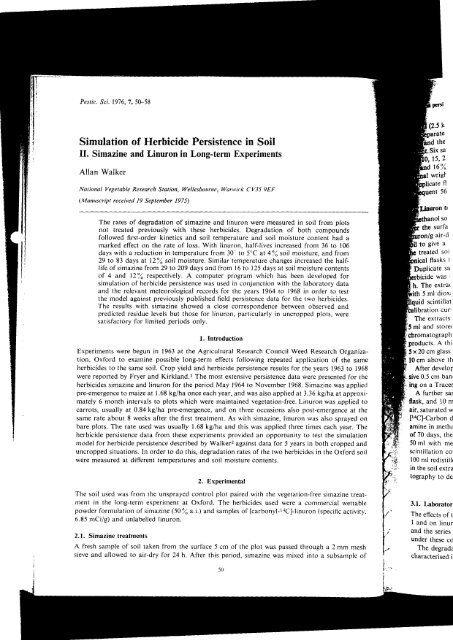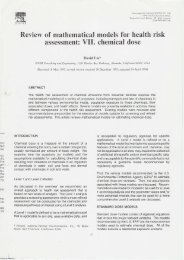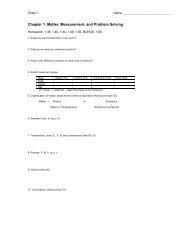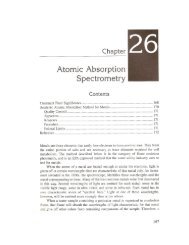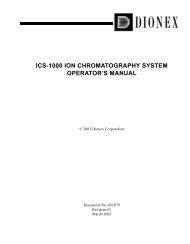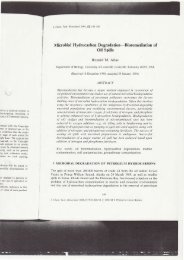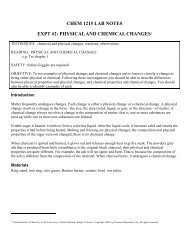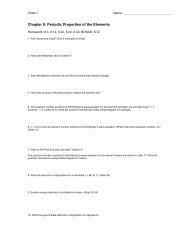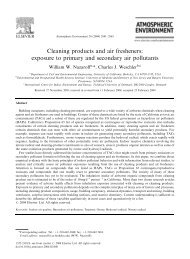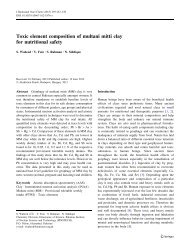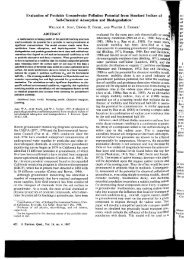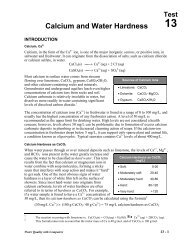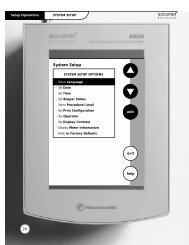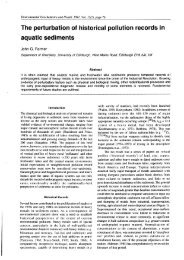Simulation of Herbicide Persistence in Soil
Simulation of Herbicide Persistence in Soil
Simulation of Herbicide Persistence in Soil
- No tags were found...
Create successful ePaper yourself
Turn your PDF publications into a flip-book with our unique Google optimized e-Paper software.
Pestic. 9ci.1976, 7, 50-58p.trsi<strong>Simulation</strong> <strong>of</strong> <strong>Herbicide</strong> <strong>Persistence</strong> <strong>in</strong> <strong>Soil</strong>II. Simaz<strong>in</strong>e and L<strong>in</strong>uron <strong>in</strong> Long-term ExperimentsAllan WalkerNational Vegetable Research Station, llellesbourne, Warx,ick CV35 gEF(Manuscripr received l9 September 1975)Qsktethe. Six sat5,2t6%weigticate fl)oThe rates <strong>of</strong> degradation <strong>of</strong> simaz<strong>in</strong>e and l<strong>in</strong>uron were measured <strong>in</strong> soil from plotsnot treated previously with these herbicides. Degradation <strong>of</strong> both compoundsfollowed first-order k<strong>in</strong>etics and soil temperature and soil moisture content had amarked effect on the rate <strong>of</strong> loss. With l<strong>in</strong>uron, half-lives <strong>in</strong>creased from 36 to 106days with a reduction <strong>in</strong> temperature from 30' to 5"C at 4lsoil moisture, and from29 to 83 days at 12\ soil moisture. Similar temperature changes <strong>in</strong>creased the halflife<strong>of</strong> simaz<strong>in</strong>e from 29 to 209 days and from l6 to 125 days at soil moisture contents<strong>of</strong> 4 and l2)( respectively. A computer program which has been developed forsimulation <strong>of</strong> herbicide persistence was used <strong>in</strong> conjunction with the laboratory dataand the relevant meteorological records for the years 1964 to 1968 <strong>in</strong> order to testthe model aga<strong>in</strong>st previously published field persistence data for the two herbicides.The results with simaz<strong>in</strong>e showed a close correspondence between observed andpredicted residue levels but those for I<strong>in</strong>uron, particularly <strong>in</strong> uncropped plots. weresatisfactory for limited periods only.I. lntroductionExperirnents were begun <strong>in</strong> 1963 at the Agricultural Research Council Weed Research Organization,Oxford to exam<strong>in</strong>e possible long-term effects follow<strong>in</strong>g repeated application <strong>of</strong> the sanreherbicides to the same soil. Crop yield and herbicide persistence results for the years 1963 to 1968were reported by Fryer and Kirkland.l The most extensive persistence data were presented for theherbicides simaz<strong>in</strong>e and l<strong>in</strong>uron for the period May 1964 to November 1968. Simaz<strong>in</strong>e was appliedpre-emergence to maize at L68 kg/ha once each year, and was also applied at 3.36 kg/ha at approximately6 month <strong>in</strong>tervals to plots which were ma<strong>in</strong>ta<strong>in</strong>ed vegetation-free. L<strong>in</strong>uron was applied tocarrots, usually at 0.84 kg/ha pre-emergence, and on three occasions also post-emergence at thesame rate about 8 weeks aiter the first treatment. As with simaz<strong>in</strong>e, l<strong>in</strong>uron was also sprayed onbare plots. The rate used was usually 1.68 kg/ha and this was applied three times each year. Theherbicide persistence data from these experiments provided an opportunity to test the simulationmodel for herbicide persistence described by Walker2 aga<strong>in</strong>st data for 5 years <strong>in</strong> both cropped anduncropped situations. In order to do this, degradation rates <strong>of</strong> the two herbicides <strong>in</strong> the Oxford soilwere measured at different temperatures and soil moisture contents.2. ExperimentalThe soil used was from the unsprayed control plot paired with the vegetation-free simaz<strong>in</strong>e treatment<strong>in</strong> the long-term experiment at Oxford. The herbicides used were a commercial wettablepowder formulation <strong>of</strong> simaz<strong>in</strong>e (50% a.i.) and samples <strong>of</strong> [carbonyl-1rC]-l<strong>in</strong>uron(specificacrivity.6.85 mCi/e) and unlabelled l<strong>in</strong>uron.2.1. Simaz<strong>in</strong>e treatmentsA fresh sample <strong>of</strong> soil taken from the surface 5 cm <strong>of</strong> the plot was passed through a 2 mm meshsieve and allowed to air-dry for 24h. After this period, simaz<strong>in</strong>e was mixed <strong>in</strong>to a subsample <strong>of</strong>the surfaair-dto give atreated soiflasks IDuplicate saide wash, The extrat5 ml diox;sc<strong>in</strong>tillatlon cur'The extracts5 ml and store:chromatograPproducts. A thi5 x 20 cm glassl0 cm above thAfter developsive 0.5 cm ban<strong>in</strong>g on a TracerA further sarflask, and 10 mair, saturated w0aCl-Carbon dam<strong>in</strong>e <strong>in</strong> methe<strong>of</strong> 70 days, the50 ml with mesc<strong>in</strong>tillation co100 ml redistill<strong>in</strong> the soil extratography to de3.1. LaboratorThe effects <strong>of</strong> tI and on l<strong>in</strong>urand the seriesunder these coThe degradzcharacterised i
Long-term persistence <strong>of</strong> simaz<strong>in</strong>e and l<strong>in</strong>uron <strong>in</strong> soilthe soil (2.5 kg) by the method previously described3 to give a f<strong>in</strong>al concentration <strong>of</strong> 4.0 pglg drysoil. Separate 25 g amounts <strong>of</strong> the treated soil were weighed <strong>in</strong>to wide-mouthed 100 ml conicalflasks and the appropriate amount <strong>of</strong> water was added to each to give the required soil moistureccntent. Six samples were prepared for <strong>in</strong>cubation at both 4 and 121 soll moisture and temperatures<strong>of</strong> 5, 10. 15,20,25 and 30'C. Further samples were <strong>in</strong>cubated at 25'C with soil moisture contents<strong>of</strong> 8 and 16)1. The <strong>in</strong>itial weights <strong>of</strong> all the flasks were recorded and they were returned to theseorig<strong>in</strong>al weights by add<strong>in</strong>g water at 7 day <strong>in</strong>tervals.Duplicate flasks from each treatment were removed for analysis on three occasions dur<strong>in</strong>g thesubsequent 56 days. The analytical method used for simaz<strong>in</strong>e has been described previously.3lotsrndsrda106romralfentsfordatatestides.andwereh Organizarfthe same963 to I 968nted for thewas appliedat approxisapplied totence at thesprayed onh year. The: simulation:ropl rndOxford soil2,2. L<strong>in</strong>ur on treatmentsA rnethanol solution conta<strong>in</strong><strong>in</strong>g50 pg IaC]-l<strong>in</strong>uron/ml and 750 pg unlabelled l<strong>in</strong>uronimlwas pipettedover the surface <strong>of</strong> a sample <strong>of</strong> the air-dry soil (2.5 kg) to give a f<strong>in</strong>al concentration <strong>of</strong> 4.0 pgl<strong>in</strong>uron/g air-dry soil. The solvent was allowed to evaporate and sufficient water was added to thesoil to give a flnal soil moisture content <strong>of</strong> approximately 4'%. Mix<strong>in</strong>g was achieved by pass<strong>in</strong>gthe treated soil several times through a 2 mm mesh sieve. Treatments were prepared <strong>in</strong> 100 mlconical flasks for <strong>in</strong>cubation under the same conditions as those used for simaz<strong>in</strong>e (section 2.1).Duplicate samples were removed for analysis at <strong>in</strong>tervals dur<strong>in</strong>g the subsequent 56 days. Theherbicide was extracted by shak<strong>in</strong>g with 50 ml redistilled methanol on a wrist-action shaker forI h. The extracts were filtered and duplicate 2 ml subsamples were transferred to count<strong>in</strong>g vialswith 5 ml dioxan-based sc<strong>in</strong>tillator.a Activities were determ<strong>in</strong>ed us<strong>in</strong>g a Tracerlab Corumatic 200liquid sc<strong>in</strong>tillation counter. Quench corrections were determ<strong>in</strong>ed us<strong>in</strong>g a sample channels ratiocalibration curve.The extracts rema<strong>in</strong><strong>in</strong>g after preparation <strong>of</strong> samples for count<strong>in</strong>g were concentrated to about5 ml and stored <strong>in</strong> glass vials at 4'C. Several <strong>of</strong> these extracts were exam<strong>in</strong>ed by the th<strong>in</strong>-layerchromatographic method described by Katzs to separate l<strong>in</strong>uron from its possible breakdownproducts. A th<strong>in</strong> streak <strong>of</strong> extract was applied to freshly prepared 250 pm layers <strong>of</strong> silica gel G on5 x 20 cm glass plates which had been activated for 30 m<strong>in</strong> at I10"C. The plates were developed forl0 cnr above the basel<strong>in</strong>e <strong>in</strong> chlor<strong>of</strong>orm-methanol-pyrid<strong>in</strong>e (100:5: I by volume).After development the plates were dried and the peaks <strong>of</strong> activity determ<strong>in</strong>ed by scrap<strong>in</strong>g successive0.5 cnr bands from the plates, dispers<strong>in</strong>g <strong>in</strong> methanol on 5 cnr alum<strong>in</strong>ium planchets and count<strong>in</strong>gon a Tracerlab, low-background, end-w<strong>in</strong>dow Geiger counter.A further sample (100 g) <strong>of</strong> the orig<strong>in</strong>al l<strong>in</strong>uron-treated soil was weighed <strong>in</strong>to a 250 ml conicalflask, and l0ml water was added to give a moisture content <strong>of</strong> about 141. Carbon
52A.Woo4% Soit moislu/ec:3l?'h <strong>Soil</strong> moisturejFlgure 2. Effr'; O, 20"; l, 25".:'rT'.T l,:f::,'!:t,r"+:erature40Trme {doys)on simaz<strong>in</strong>e degradation at 4 and r2lsoitmoisture. A,5.; a, 10"; o, 15.;OU20cTable l' The effects <strong>of</strong> temperature and soil moisture content on simaz<strong>in</strong>e and l<strong>in</strong>uron degradationL<strong>in</strong>uron<strong>Soil</strong> moisturecontent(%)Simaz<strong>in</strong>e+812l68l2loI0683209125I{alf-life (days) at temperature (oC)l0 l5 20 25 30;o,384 67 5745 36:50Il=63I5343I293414080show that the effects <strong>of</strong> soil moisture content on the rate <strong>of</strong> degradation aretemperaturessimilar atfortheanydiflerentone herbicide. with t<strong>in</strong>uron a reduction from 12\75)(<strong>of</strong>soil moisturefieldcapacitv)tolT.soil(aboutmoisture (25/,otfieldcapacity;<strong>in</strong>creaseothehalflifebyabout30"1 and a similar change with simaz<strong>in</strong>e <strong>in</strong>creasld the half-life by about g0f(.similar to Thesethose reported <strong>in</strong>creases areby Usoroh and Hance,? and walker3 forl<strong>in</strong>uron and simaz<strong>in</strong>e respectively.925360344028162329l6toc?5t?.3Figure 3. Effe,l, 25'; n, 30'
A. WalkerLong-term persistence <strong>of</strong> simaz<strong>in</strong>e and l<strong>in</strong>uron <strong>in</strong> soil 53oo:-csot.o4.047" Sorl morstureiai2% <strong>Soil</strong> morslure40Tlme (doys )Figure 2. Effects <strong>of</strong> temperature on l<strong>in</strong>uron degradation at 4 and lzlO, 20'; l' 25"; C, 30'C.soil moisture.' l' 5'; a, lo";S rmoz <strong>in</strong>eruron degradation\_\*--.-----t-.--*--.-.2530E4542JI343629a-.--\---*----.-a4028262329l6milar at the different;oil moisture (abouthe halfJife by about. These <strong>in</strong>creases areimaz<strong>in</strong>e respectively.Z.f, 5 tO ?.O 2.5Sorl moislu.e content {o/");Flgurer' Effects<strong>of</strong>soilmoisturecontentonsimaz<strong>in</strong>eandt<strong>in</strong>urondegradation.A,5.; a,r0"; o,r5"; o,20";l, 25'; n, rO.c.
A. Walker Wry-term <strong>Persistence</strong> <strong>of</strong>A feature <strong>of</strong> the results <strong>in</strong> Table I is the greater effect <strong>of</strong> both soil temperature and soil moisturecontent on the rate <strong>of</strong> degradation <strong>of</strong> simaz<strong>in</strong>e compared with l<strong>in</strong>uron. The half-life <strong>of</strong> l<strong>in</strong>uron <strong>in</strong>soil at 30"C andl2l soil moisture is almost twice that <strong>of</strong> simaz<strong>in</strong>e, whereas at4lsoil moistureand 5"C, the half-life <strong>of</strong> simaz<strong>in</strong>e is almost twice that <strong>of</strong> l<strong>in</strong>uron. The relationships between halflivesand soil moisture content are shown for both simaz<strong>in</strong>e and l<strong>in</strong>uron <strong>in</strong> Figure 3. The straightl<strong>in</strong>es drawn through the data at 25"C show an approximate fit to the empirical equation relat<strong>in</strong>gthe half-life (H) to soil moisture content (M):H:AM B (l)<strong>in</strong> which A and B are constants. This equation has previously been shown to fit similar data withpropyzamidee, napropamide,2 simaz<strong>in</strong>e3 and prometryne.3 The fact that straight l<strong>in</strong>es with similarslope to that at 25"C can be drawn through the two po<strong>in</strong>ts at the other temperatures is a furtherillustration that the relative effects <strong>of</strong> moisture content on degradation rates are similar at differenttemperatures.The relationship between the rates <strong>of</strong> degradation <strong>of</strong> both herbicides and temperature can beexpressed <strong>in</strong> terms <strong>of</strong> the Arrhenius equation:' Ht lF'l l\be'n,:#i(n-Z I tzt<strong>in</strong> which Ht and 11: are the half-lives at temperatures Ir and Tz and -lE is the activation energy.The relationships between the half-lives <strong>of</strong> simaz<strong>in</strong>e and l<strong>in</strong>uron and temperature at 4 and 12i(soil moisture are shown <strong>in</strong> Figure 4, <strong>in</strong> which the half-life on a logarithmic scale is plotted aga<strong>in</strong>st;= oro.oo35| /Absolute temperolure ( K -')Figure 4, Test for the fit <strong>of</strong> the Arrhenius equation to data for simaz<strong>in</strong>e and l<strong>in</strong>uron degradation. O,4%<strong>Soil</strong>moisture ; O, l2',r" soil moisture.the <strong>in</strong>verse <strong>of</strong> the absolute temperature. From the slopes <strong>of</strong> the l<strong>in</strong>es, the activation energy forl<strong>in</strong>uron degradation is calculated as 30.2 kJ/mol and for simaz<strong>in</strong>e as 57.4kJ/mol.The data for l<strong>in</strong>uron degradation <strong>in</strong> Figure 2 and Table I were based on the amounts <strong>of</strong> radioactivityextracted from the soil expressed as concentrations <strong>of</strong> l<strong>in</strong>uron. The th<strong>in</strong>-layer chromatograms<strong>of</strong> the extracts from the samples <strong>in</strong>cubated at 25"C and all the extracts at 56 days showedthat over 957" <strong>of</strong> the activity on the plates was located at the Rr,-value <strong>of</strong> the parent herbicide(between 0.90 and 0.95), therefore demonstrat<strong>in</strong>g that <strong>in</strong> experiments with [carbonyl-1aC]-l<strong>in</strong>uronchanges <strong>in</strong> extractability <strong>of</strong> radioactivity give a valid measure <strong>of</strong> l<strong>in</strong>uron degradation. This con-clusion is further suPl<strong>in</strong> Figure 5. The amotloss <strong>of</strong> [raC]-carbon don a log scale aga<strong>in</strong>sexpressed as l<strong>in</strong>uron,spondence with first-'srooQa\t z,)between the calculategraphic analysis <strong>of</strong> tt<strong>of</strong> the extractable raCthose <strong>of</strong> Bcirner,lo wcarbonyl group and n3.2. <strong>Simulation</strong> <strong>of</strong> peThe meteorological rrand l0 cm soil temp(the computer prograrsoil temperature ancNational Vegetable IWeed Research Orgaweather records arepattern, on a day-tosimulation program'simulation program €simaz<strong>in</strong>e plots <strong>in</strong> Figl<strong>in</strong>uron plots are sho,with the simulation n<strong>of</strong> measured residueThe results from theactual amounts repeidicted and to give thThe results with sshape to those obserrthe uncropped plots,the determ<strong>in</strong>ed resid0.56 to l.g9 kg/ha wPlots, and the model
A. WalkerIrng-term persistcnce <strong>of</strong> simaz<strong>in</strong>c and l<strong>in</strong>uron <strong>in</strong> soil55d soil moistureie <strong>of</strong> l<strong>in</strong>uron <strong>in</strong>( soil moistures between half-3. The straightuation relat<strong>in</strong>gclusion is further supported by the results from collection <strong>of</strong> ILlc]-carbon dioxide which are shown<strong>in</strong> Figure 5. The amount <strong>of</strong> l<strong>in</strong>uron rema<strong>in</strong><strong>in</strong>g <strong>in</strong> the soil (calculated by subtraction <strong>of</strong> the cumulativeloss <strong>of</strong> [1aC]-carbon dioxide from the radioactivity present <strong>in</strong>itially, expressed as l<strong>in</strong>uron), is plottedon a log scale aga<strong>in</strong>st time <strong>of</strong> <strong>in</strong>cubation. Also shown is the value for extractable activity, aga<strong>in</strong>expressed as l<strong>in</strong>uron, on term<strong>in</strong>ation <strong>of</strong> the experiment at 70 days. The data show a close correspor.ldencewith first-order k<strong>in</strong>etics giv<strong>in</strong>g a half-life <strong>of</strong> about 30 days. There was good agreement(l)nilar data withres with s<strong>in</strong>rilarres is a furtherilar at differentt coFs50= :_..erature can be(2)ivati< .tergy.at 4 and 12\plotted aga<strong>in</strong>st:n. C, 4i{ <strong>Soil</strong>In energy forrnts <strong>of</strong> radio-3r chromato-Cays showed:nt herbicide.raClJ<strong>in</strong>uronn. This con-6(d 4t fbTime {doys)Figure 5, Loss <strong>of</strong> l<strong>in</strong>uron from soil calculated fromcumulative amounts <strong>of</strong> liCOz collected ( o) and amount<strong>of</strong> l<strong>in</strong>uron extracted from the soil after 70 days (O).between the calculated amount rema<strong>in</strong><strong>in</strong>g after 70 days and that determ<strong>in</strong>ed. Th<strong>in</strong>-layer chromatographicanalysis ol the methanol extract at the end <strong>of</strong> the experiment aga<strong>in</strong> showed that over 957"<strong>of</strong> the extractable radioactivity was <strong>in</strong> the form <strong>of</strong> l<strong>in</strong>uron. These data are therefore consistent withthose <strong>of</strong> Bcirner,lo which showed that loss <strong>of</strong> l<strong>in</strong>uron from soil is closely related with loss <strong>of</strong> theerbonyl group and not associated with buildup <strong>of</strong> the demethylated or demethoxylate derivatives.3.2. <strong>Simulation</strong> <strong>of</strong> persistence <strong>in</strong> the fieldTh,) nleteorological records <strong>of</strong> ra<strong>in</strong>fall (mm/day), evaporation from an open water surface (mm/day)and l0cm soi[ temperature ("C) for the period January 1964to December 1968 were comb<strong>in</strong>ed <strong>in</strong>the computer programz with the respective constants relat<strong>in</strong>g half-lives <strong>of</strong> simaz<strong>in</strong>e or l<strong>in</strong>uron withsoil temperature and soil moisture content. The weather data used were those recorded at theNational Vegetable Research Station s<strong>in</strong>ce evaporation measurements were not available from theWeed Research Organization. The two stations are approximately 35 miles apart, and the averageweather records are very similar. There would have been differences, particularly <strong>in</strong> the ra<strong>in</strong>fallpattern, on a day-to-day basis, but such differences were probably <strong>of</strong> little importance when thesimulation program was run for long periods. The disappearance curves obta<strong>in</strong>ed from use <strong>of</strong> thesitnuiation program are compared with the published results <strong>of</strong> Fryer and Kirklandl flor the croppedsimaz<strong>in</strong>e plots <strong>in</strong> Figtrre 6 and for the uncropped plots <strong>in</strong> Figure 7. Similar results for the croppedl<strong>in</strong>uron plots are shown <strong>in</strong> Table2,and for the uncropped plots <strong>in</strong> Table 3. In previous experimentswith the simulation model, the determ<strong>in</strong>ed degradation curves have been drawn follow<strong>in</strong>g correction<strong>of</strong> measured residue levels for <strong>in</strong>itial recoveries2,3'e but <strong>in</strong> the present study this was not done.The results from the model, shown <strong>in</strong> Figures 6 and 7 and Tables 2 and 3 were calculated us<strong>in</strong>g theactual amounts repeatedly applied, <strong>in</strong> order to determ<strong>in</strong>e whether residue build-up would be predictedand to give the model a strict test aga<strong>in</strong>st field results.The results with simaz<strong>in</strong>e are encourag<strong>in</strong>g: the simulated disappearance curves are <strong>of</strong> similarshape to those observed and the predicted residues are <strong>of</strong>ten very similar to those determ<strong>in</strong>ed. Withthe uncropped plots, the predicted residue at the end <strong>of</strong> the fifth year is 0.58 kg/ha compared withthe determ<strong>in</strong>ed residue <strong>of</strong> 0.63 kg/ha. Fryer and Kirklandl conclude that a residue vary<strong>in</strong>g from0'56 to 1.89 kg/ha was present <strong>in</strong> the soil at the time <strong>of</strong> the next application <strong>of</strong> simaz<strong>in</strong>e to theseand the model predicts a m<strong>in</strong>imum residue <strong>of</strong> 0.49 kg/ha follow<strong>in</strong>g spr<strong>in</strong>g application and a
56 A. Walker persistence o,.oI?t1964/3 r965/6ooo\.\oEoi z.oct966/ 76080t967/8tro0t20r40r50r80200Time ( weeks )Figure 7. PersistencFigure 6. <strong>Persistence</strong> <strong>of</strong> simaz<strong>in</strong>e <strong>in</strong> cropped plots. O, Observed; o, simulated; time 0:27 May 1964.WeeksafterDate Dose applisprayed(kg/ha) cation12.6.64 t.t2 085.8.64 0.56 07l42725.5.65 0. 84 0822.7 .65 0. 84 06l32l2835Table 2. <strong>Simulation</strong> <strong>of</strong> l<strong>in</strong>uron persistence <strong>in</strong> the cropped plotsResidue (ke/ha)Observed0. 700.420. 980. 700. 70.,:0.l40. 63Simulated.:0. 14 0. 380. 98 (0. 98)' l . 220.49 (0.57) 0.710.42 (0.35) 0.430.21 (0.24) 0.290.21 (0.18) 0.22
A. Walkerpersistence <strong>of</strong> simaz<strong>in</strong>eL,ong-termand l<strong>in</strong>uron <strong>in</strong> soilI.,olL',--c'o^-
.\. WalkerTable 3. <strong>Simulation</strong> <strong>of</strong> l<strong>in</strong>uron persistence <strong>in</strong> uncropped plotsDatesprayedResidue (kgi ha)Dose Weeks after(kg/ha) application Observed Simulated12.6.645.8.&28.tO.6425.5.65zt.t.6J2.24t.t2l 68I .68I .680807l206t2l82329080bl21.820. 9l2.52| .47t.262.66l .541 .260. 98r .050.77l .401 .332.943.36.3.992.24r.042.16l.200. 902. 58l .931.55| .250. 990. 64) ?fI .042.72L59l.0la From this oo<strong>in</strong>t onwards the observedata become unreliable.and l<strong>in</strong>uron to this particular soil will not lead to a buildup <strong>of</strong> residues <strong>of</strong> either herbicide. Theyconfirm the conclusions <strong>of</strong> Fryer and Kirklandr that repeated applications <strong>of</strong> simaz<strong>in</strong>e for 5 yearsdid not alter the soil's capacity to degrade the herbicide, but the discrepancies between observedand predicted l<strong>in</strong>uron residues follow<strong>in</strong>g three applications <strong>of</strong> relatively high doses <strong>in</strong> each <strong>of</strong> fivesuccessive years suggest the possibility that some change did occur.AcknowledgementsThanks are expressed to Mr H. A. Roberts for his encouragement dur<strong>in</strong>g this work and to MissP. A. Brown for technical assistance.Referencesl. Fryer, J. D.; Kirkland, K. ll'eed Res. I970, 10, 133.2. Walker, A. J. Environ. Quality 1974,3,396.3. Walker, A. Pestic. Sci. 1976,7, 41.4. Bray, G. A. Analvt. Biochem. 1960, 1,279.5. Katz, S. "/. l.rs. <strong>of</strong>. anolyt. Chem. 1967,50,912.6. Hance, R. J. Pesrlc. Sci. 1973, 4. 817.7. Usoroh, N. J.; Hance, R. J. l4eed Res. 1974, 14, 19.8. Obien, S. R.; Creen, R. E. lleed Sci. 1969, 17, 509.9. Walker, A. In Proceed<strong>in</strong>gs European lYeed Research Council Synposiunt, Herbicidts and the <strong>Soil</strong> Paris, 1973,p.240.10" Borner, H. Z. P.flnnzenkrankh Pfanzensthutz 1965,7?-,516.Ycgetable Rcsrccelved 19Thc effects <strong>of</strong><strong>of</strong> propyzamidHalf-lives <strong>in</strong> srfrom 63 to I Icapacity was fiwith the relevaprogxam, predplots were <strong>in</strong>residues <strong>of</strong> Prtments concerthose observecomputer progJto predict theiments.z The mrare made undermoisture contenlmodel are <strong>in</strong> goobe specific to thtThe present experpropertisoil type, and to drapply to oth(<strong>in</strong> lettuce,thharvest was also (2.1. Materials<strong>Soil</strong>s from flve fieldproperties are showrconcrete slabs sunki<strong>of</strong> about 25 cm withraked level, andfrom the field uThe herbicide use


